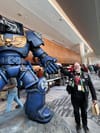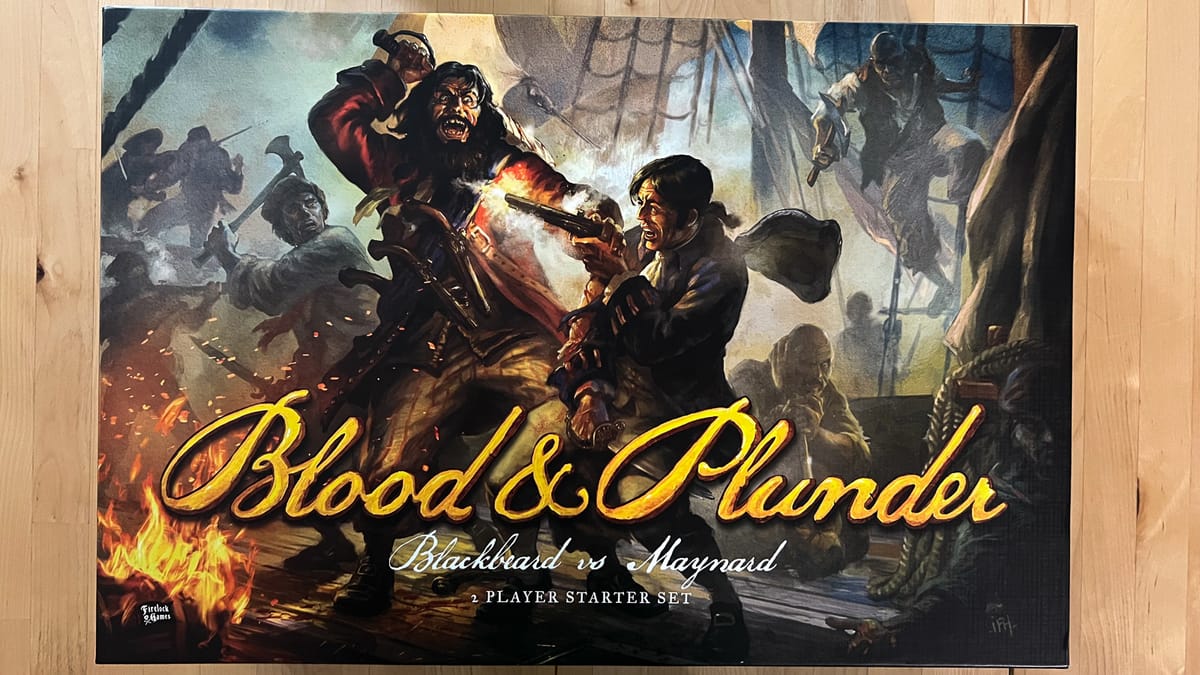
This is by far the most time I’ve spent analyzing and preparing a game for review. After a month of assembling, painting, reading, and finally playing Blood & Plunder by Firelock Games, I will say that this game is perfect for the history and pirate loving gamer in your life, but if you’re not interested in historical wargaming, this might not be your cup of grog.
Let’s dig in.
Firstly, this game is massive, from both a physical perspective and a content perspective. What you get for roughly $145USD is a 160 page softcover book which covers all of the games mechanics and history, 24x 28mm sailor models with various accessories and pose options, 2 hero models, 2 plastic ship kits, 2 activation decks, 3 gauges, punch-board terrain, 6d10, various markers, a cardboard ruler, and a 3×3 mat with both land and sea options. This is a terrific deal, and everything has a high build quality. The plastic miniatures are also well made, similar to the kind you would get with Warhammer or other similar wargames. The rulebook is extensive and large, including all of the rules, game modes, and roughly twenty some odd pages dedicated to the entire history of piracy, which was unexpected, but really helps set the tone. All of this is contained in a box that is Gloomhaven sized.
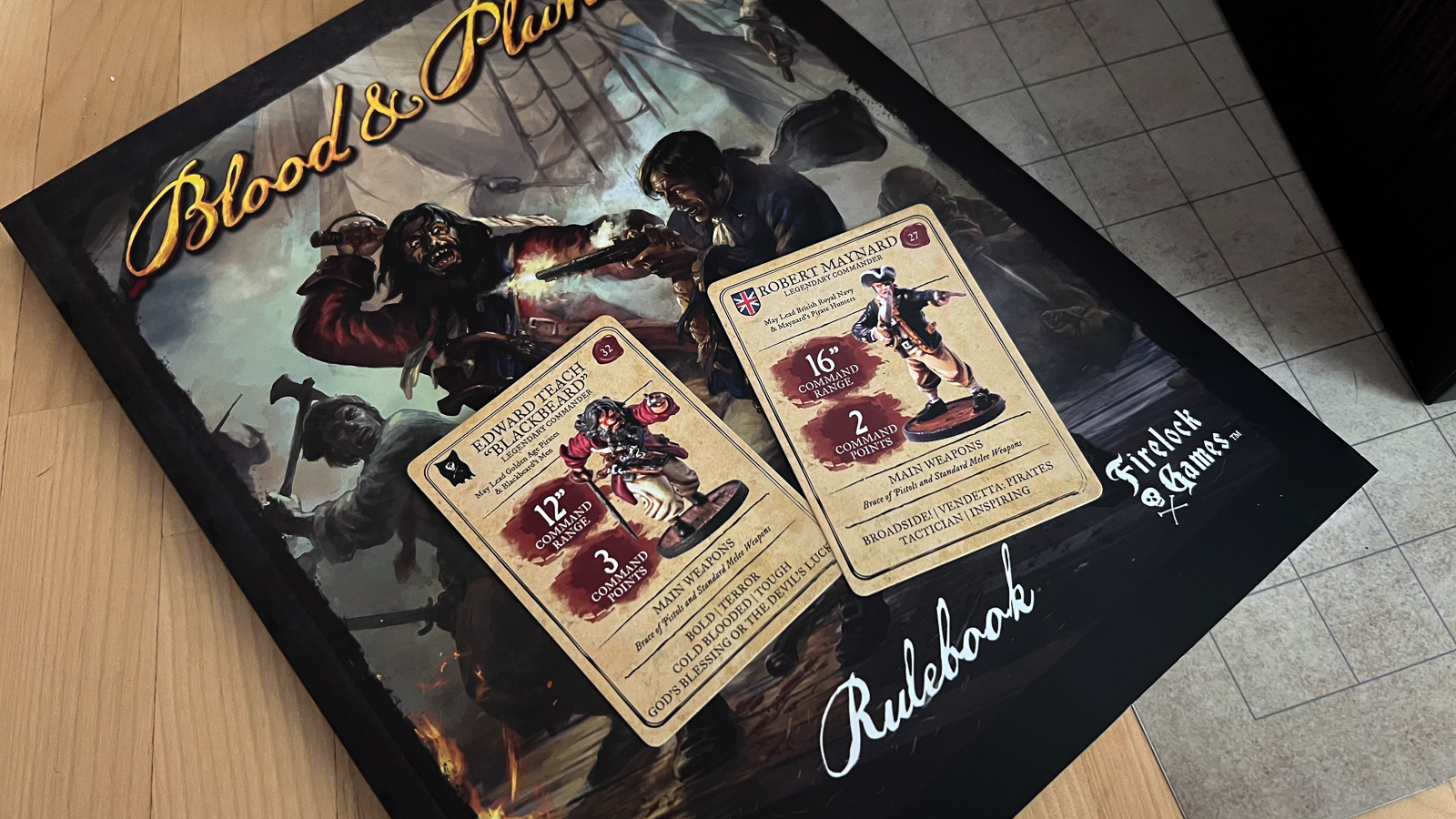
Commander cards provide details and flexibility for combat
The box is sturdy, with a molded plastic liner, although once you build the models, everything kind of just floats in the box, which could lead to broken models. The other issue is that because of the size of the box, it’s cumbersome, and if you don’t have large game storage at home, you’re going to have a bad time. I wish Firelock had put more time into considering storage within the box, especially considering this is a miniatures game, and there are a lot of tiny pieces that could be broken or lost and other games have solved this problem in the past.
Building the models
As a lead editor for all things hobby focused on Gaming Trend, I wanted to take special care and attention to building the models, and I will confidently say that if you’ve never built miniatures before, this game will make you hate this task.
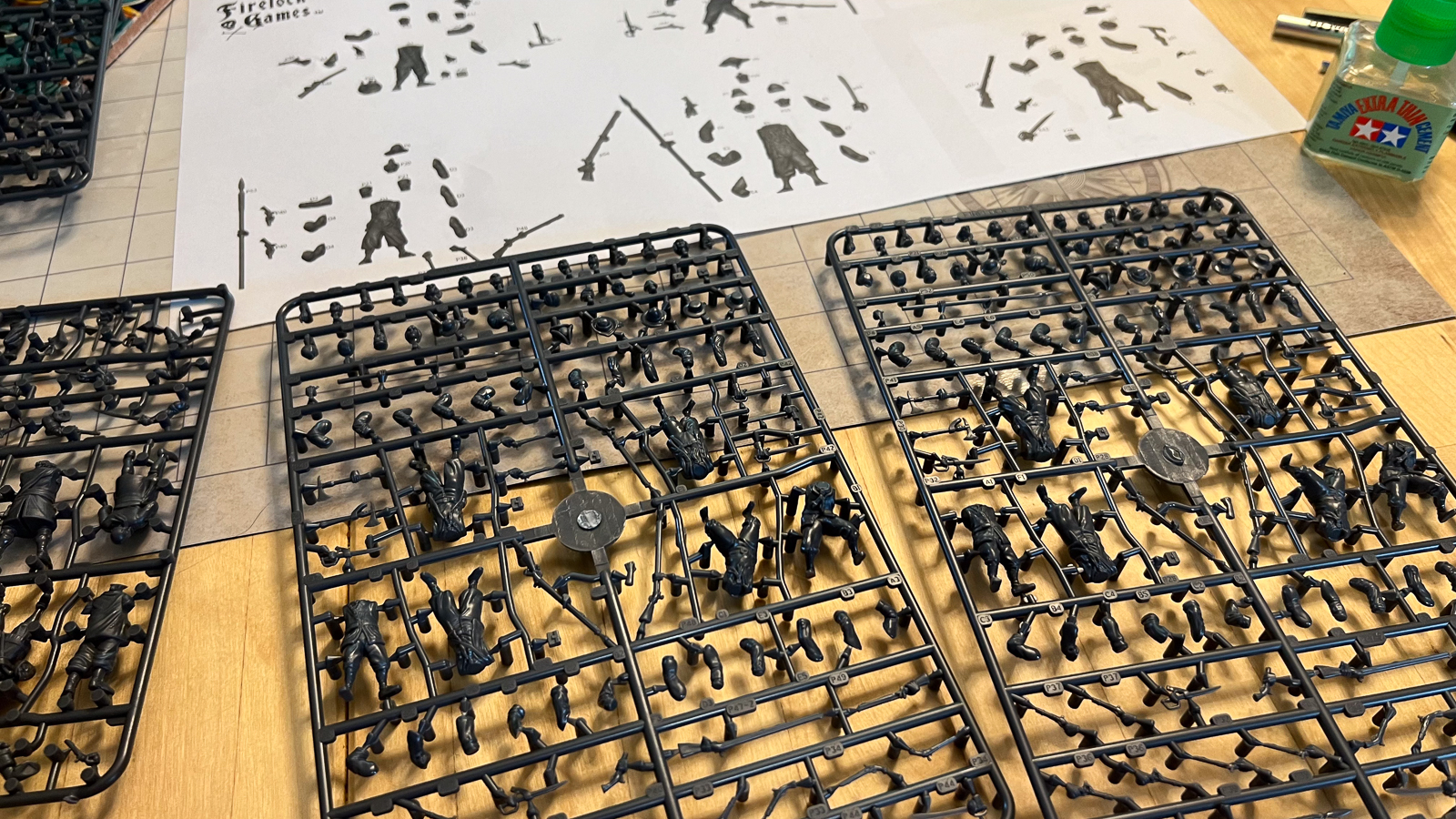
There are plenty of options for the 24 pirates this box provides you.
There are several key issues which make assembly a complete pain. Firstly, each model provides you with options for poses, weapons, and heads. However, it’s not clear in the instructions how these options should fit together. You’ll accidentally clip a weapon and then realize you didn’t use the correct arms, which leaves you struggling to find a combination that works. This becomes a bigger problem with head choices. Many heads come without a hat attached, which leads you to think you can really mix the choices together. Unfortunately, that is not the case, which could lead to frustration, and clipping too many hat pieces. This would have been easily fixed in production if Firelock had just made full heads with hats already attached.
Lastly, these models are 28mm realistic scale, which means the weapons are tiny. Unless you’re very good with gluing or using a plastic cement, you’re going to deal with a lot of glue. Even then, you’ll be afraid of pieces snapping (and they did). At this scale, the level of customization feels unnecessary. Some of the details, like a hand holding a stinkpot, or a sack of firebombs, are almost too small.

The ship sprues are intense, and include a lot of small pieces.
When it comes to boat assembly, you’re better off finding a video on Youtube that explains the process, as once again, the amount of pieces makes it incredibly difficult to put together. Not to mention that there is an ideal way to build these, but it isn’t clear in the slightest. Once again, Youtube is your friend. The amount of plastic on the sprue once again makes me question the design philosophy of these pieces. If the side of the boat is supposed to have 8 small pieces attached to another small piece before attaching it to the boat, why not just design the sprue to have those pieces attached? It’s almost like this game suffers from too much customization, and was a blocker for me to be able to enjoy ship combat, as I didn’t have the time to assemble the ships properly.
I can see some readers disagreeing with me, that assembly and customization are as vital to wargaming as the rules of combat, but this doesn’t feel like customization.It instead feels like they shipped an untested product advertised as “customization”.
However, at Adepticon, I received a sprue for Firelock’s new game, Port Royal, and I am happy to let you know they fixed these issues. Less model customization, but nicer models with richer details and much easier assembly. It’s clear they’ve learned how to make an easier time of model building!
Painting
Now, onto something entirely enjoyable, painting the models! If you’ve ever wanted to practice army painting or speed painting, then this is the perfect game to paint, as you have 24 nearly identical models to spend time on.
Personally, I broke up each model into groups of 4 and gave myself different goals for each group. Spend as little time as possible, only use 3 to 4 colors per model, try different paints from different companies, use a dry palette only, use a wet palette only, et cetera. Also, because of my time constraints, and some of the detail of the models, I elected to skip painting eyes. These models are for the table, not for competitive or display painting. Keep that in mind if you’re painting a board game or a wargame…sometimes, done is better than perfect, and you can always add more paint later.
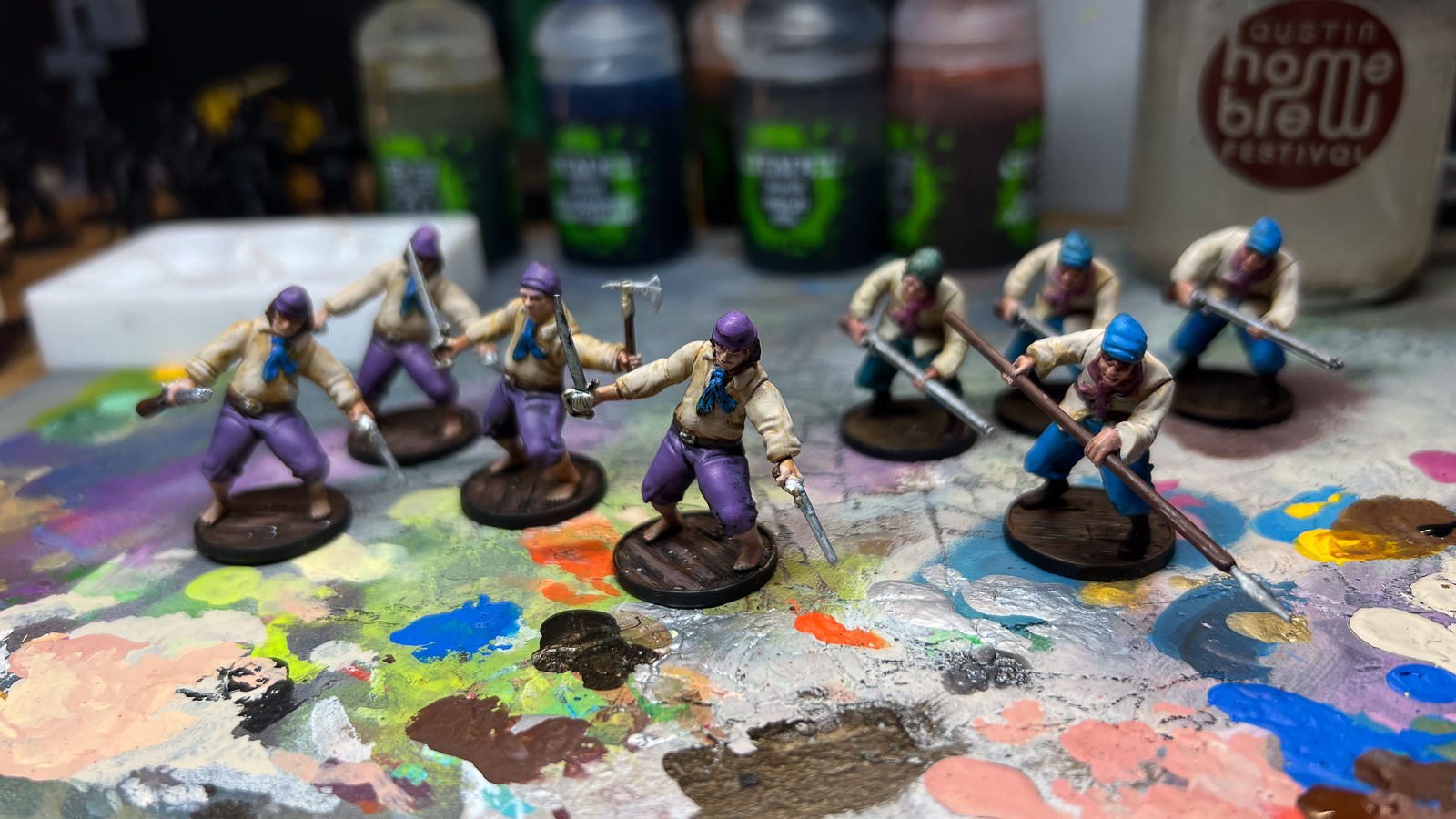
These were speedpainted, with a limited palette, but you can do far more if you want!
Here’s some examples of that work. For most of these, I tried to come up with recipes for clothing. For example, most of these models have traditional frilly pirate shirts, so that was a mixture of tans and yellows, followed up with simple dark washes, in order to create a sweaty shirt that’s seen its fair share of voyages. Same with the pants, I laid down a base coat going as dark as I could within a color range, then hitting them with a corresponding dark wash. This gives me a bit of contrast to start with. My layering process involved utilizing my basecoat mixed with lighter tones in the same color range, moving from darker tones to a lighter highlight.. Using a paint system that’s based in triads, like Army Painter’s new Fantatics line or Reaper Paints definitely helps, as you don’t need to spend a lot of time choosing colors.
As I started to get to the end of the army, I began spending more time on the models, creating cleaner highlights, deeper shadows, more interesting mixtures of color. I achieve this primarily through the use of complementary colors, and just relying on color theory. For example, on the models in the picture below, you’ll see that the coat is a greenish blue, and the pants are a reddish orange. There’s also highlights & shadows done with different colors. The darker areas are more purple, the lighter areas are more blue. This provides a nice contrast with the skintones, hair, and accessories.

The models included are great for practicing various techniques.
Metallics were used universally as a quick way to paint weapons, belt buckles, rivets, edges of hats. The Army Painter range provided me enough variety to keep it interesting on the models, and worked very well with washes and layering to get the results I wanted. The metallics give the models that extra factor that helps them look nice on the table, as the pigment can pick up light from any angle.
On average, I spent between 1 hour to 3 hours max per unit, with the fastest unit being the blue pants/blue hats taking maybe 45 minutes. The lesson here is that when it comes to speedpainting, have a plan, make concessions, and focus on getting it table ready vs correct.
The Hero Models
In Blood & Plunder, each force gets a commander model, and as expected, these models are more dynamic looking, and were a blast to paint. Blackbeard & Maynard were the models I spent the most time on. Both of these models took about 6-10 hours to complete, spread out over a 3 day period. Once again, even on these models, I didn’t bother painting the eyes fully, as no one is ever really going to see them. But everything else, I used my same techniques, just more colors and application of technique.
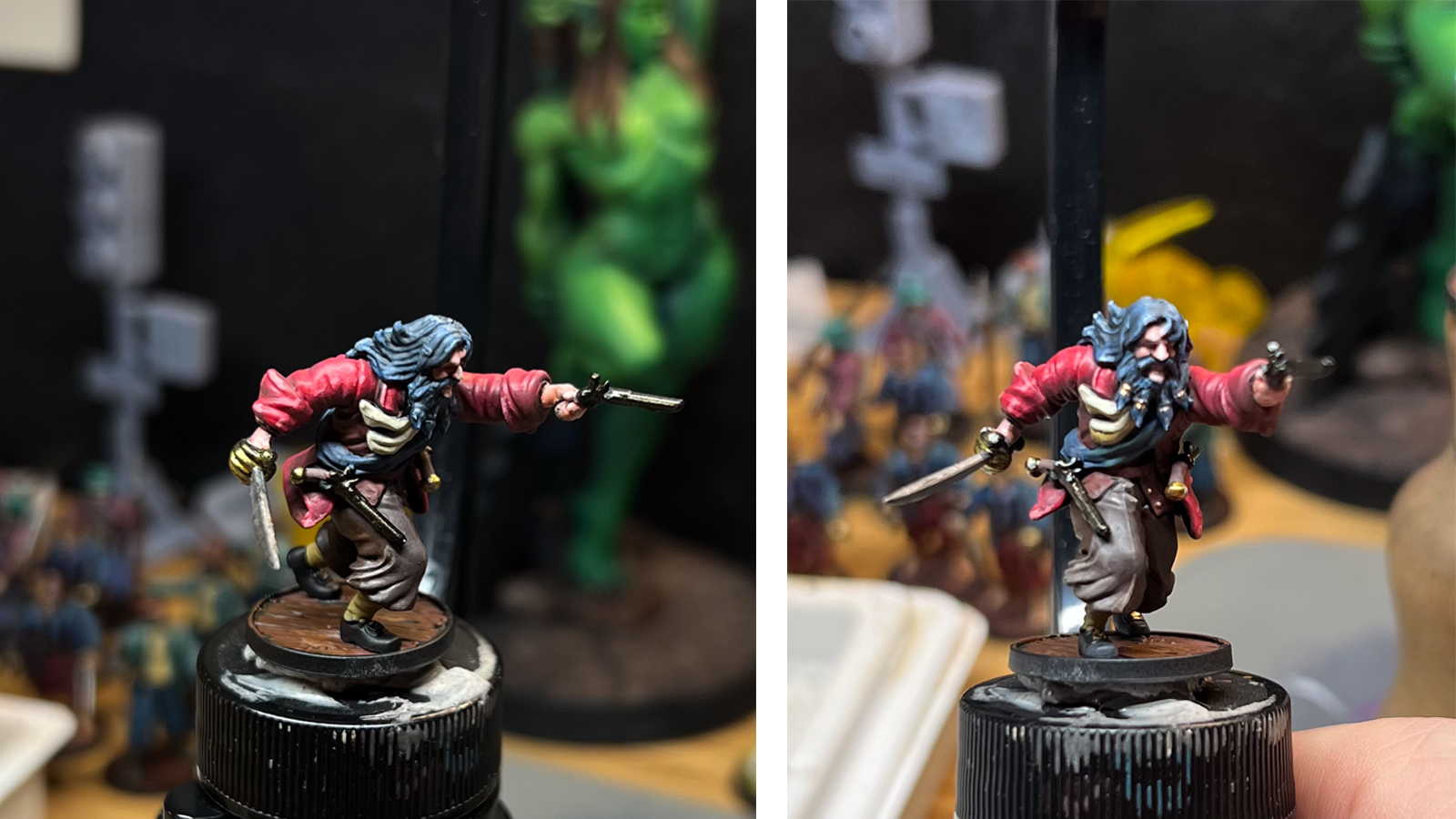
Blackbeard’s model is dynamic and exciting.
Blackbeard’s hair started as a deep blue, then I layered on grayish-blues and eventually brought them to a brilliant white highlight, which is to mimic black hair reacting to sunlight. His coat was a deep magenta, brought into pinks and ultimately a titanium white highlight. Maynards coat also started as deep blue, brought up through a lighter cyan palette, eventually ending at white. For time’s sake, I kept their pants the same, started dark browns, and layered on greenish grays to give me highlights. My old shirt recipe worked well for Maynards frills, and the metallics I had used elsewhere came back for the weapons and clothing details.
Could I have done more? Absolutely. I could have added scratches to all of the leather, painted the weapons with NMM (non metallic metal) paints, introduced yellows and oranges for my red highlights…but they looked good enough for the table. And as I wrote at the top of this article, there is always more time to put paint on a model.
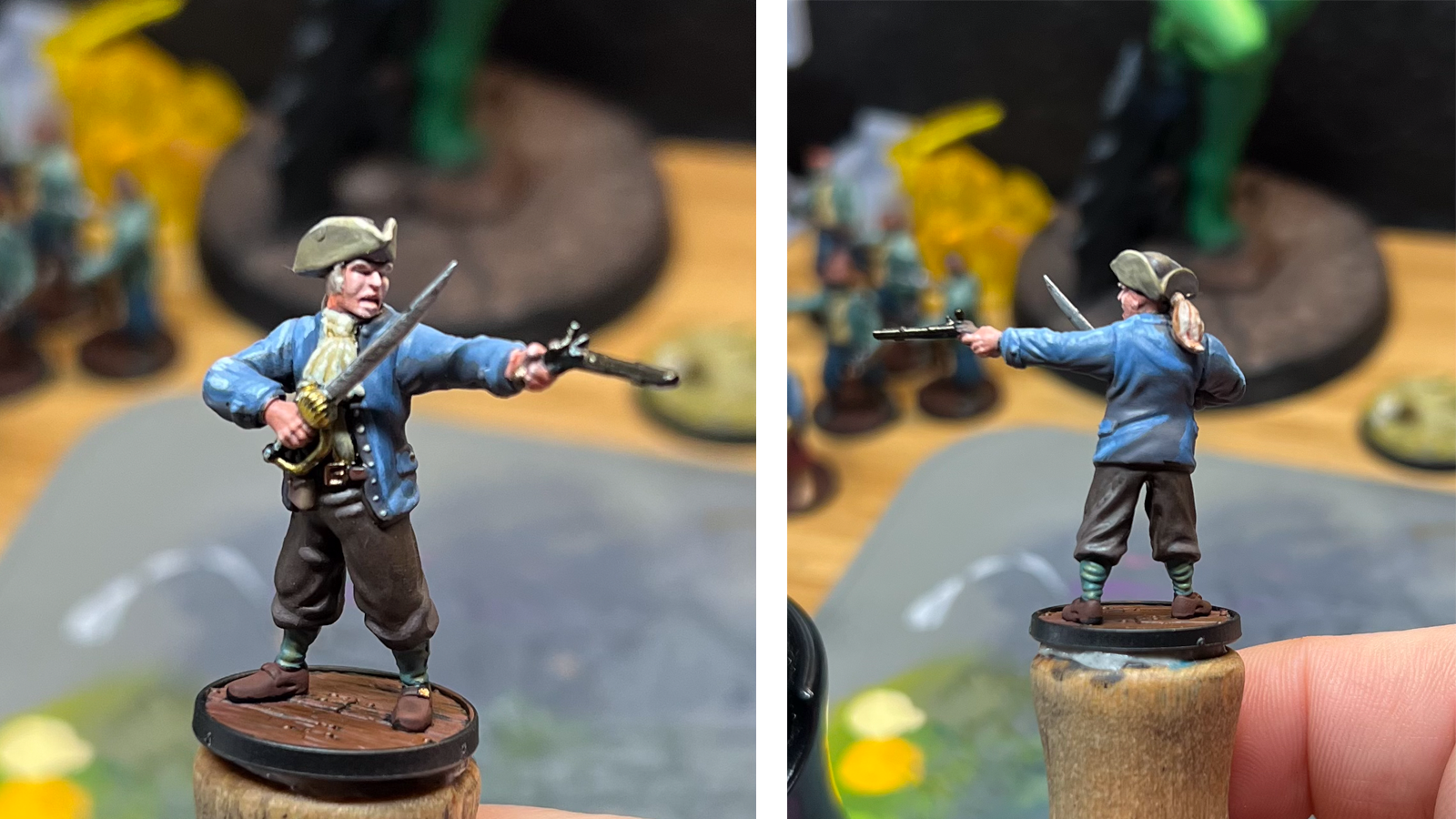
Maynard’s model has a stoic pose, allowing for a nice focus on lighting.
Ultimately, when it comes to painting a large project like this, you, the player/hobbyist, get to set the rules, and determine what is reasonable for your needs. But don’t get wrapped up in trying to paint the perfect model, or else you’re going to burn yourself out. Multiple times on this project, I found myself not inspired, and wanting to paint something else, it gave me a new appreciation for painters who take on commissions and larger armies. Hats off to y’all historical painters and wargame enthusiasts.
The Game
Blood & Plunder is a very approachable wargame. Like other wargames, there are the usual rules. Units have special abilities and are built from points and models, distance is measured by a ruler, terrain either hinders or helps units, there are special markers for units, and tests rule everything.
How Blood & Plunder stands out is the use of the Activation Deck, which is a simple deck of 54 cards. Initiative and unit actions are decided by suits, and random events are decided by jokers. Players draw up to a hand that matches the amount of units on the table, choose a card and place them at the same time. This repeats until the units are all activated, then the process repeats itself. Continue this until the objective is met or your opponent is vanquished.
There is a fatigue system which penalizes players for pushing units to have an additional action, which can severely hinder a player’s ability to act, but it’s clearly designed for special situations, where strategy may dictate the necessity of taking on fatigue.
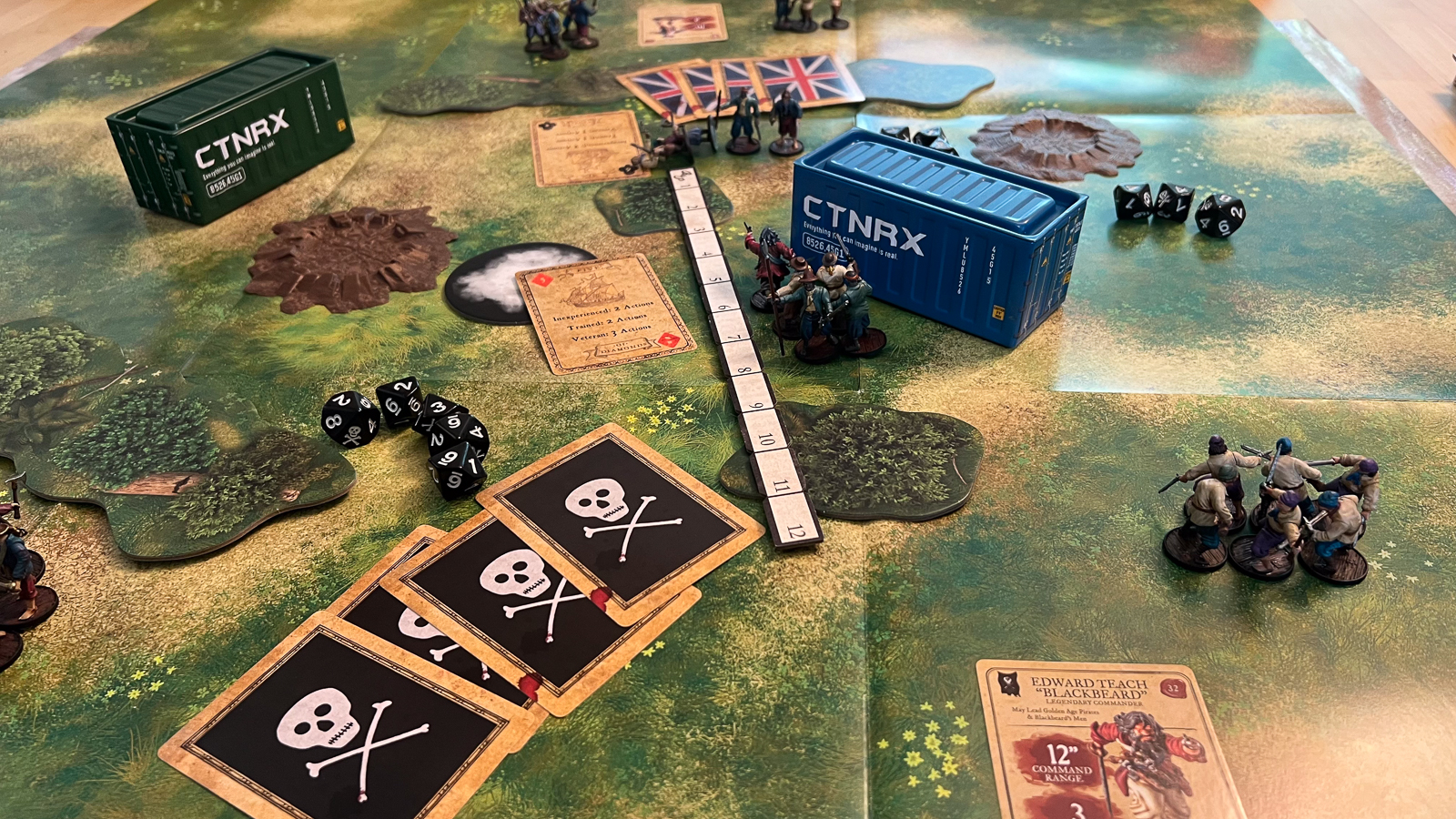
Gameplay is similar to other wargames
Commander models are similar but they can spend Command Points to give actions to any unit. This can allow a player to make more complex decisions and strategies.
Combat is handled through tests that relate back to your unit’s Skill and Save values, d10+ the value. Hits are resolved via a fatigue test, which is affected by any casualties. Terrain, placement, the choice of small arms over melee, all of these provide modifiers that affect the tests. People who are new to wargaming may want to watch a video or two about how this works, but anyone who has spent time playing TTRPGs will understand this system pretty easily.
This is where the included book is very handy. It comes full of diagrams, tables, and rulings. Effectively, everything is covered in this book, which is handy. I do suggest having a series of bookmarks when you start playing, as we had to refer back to the rules often. Also, make copies of the tables and charts for the units because it’s way easier than opening the book and going back and forth.
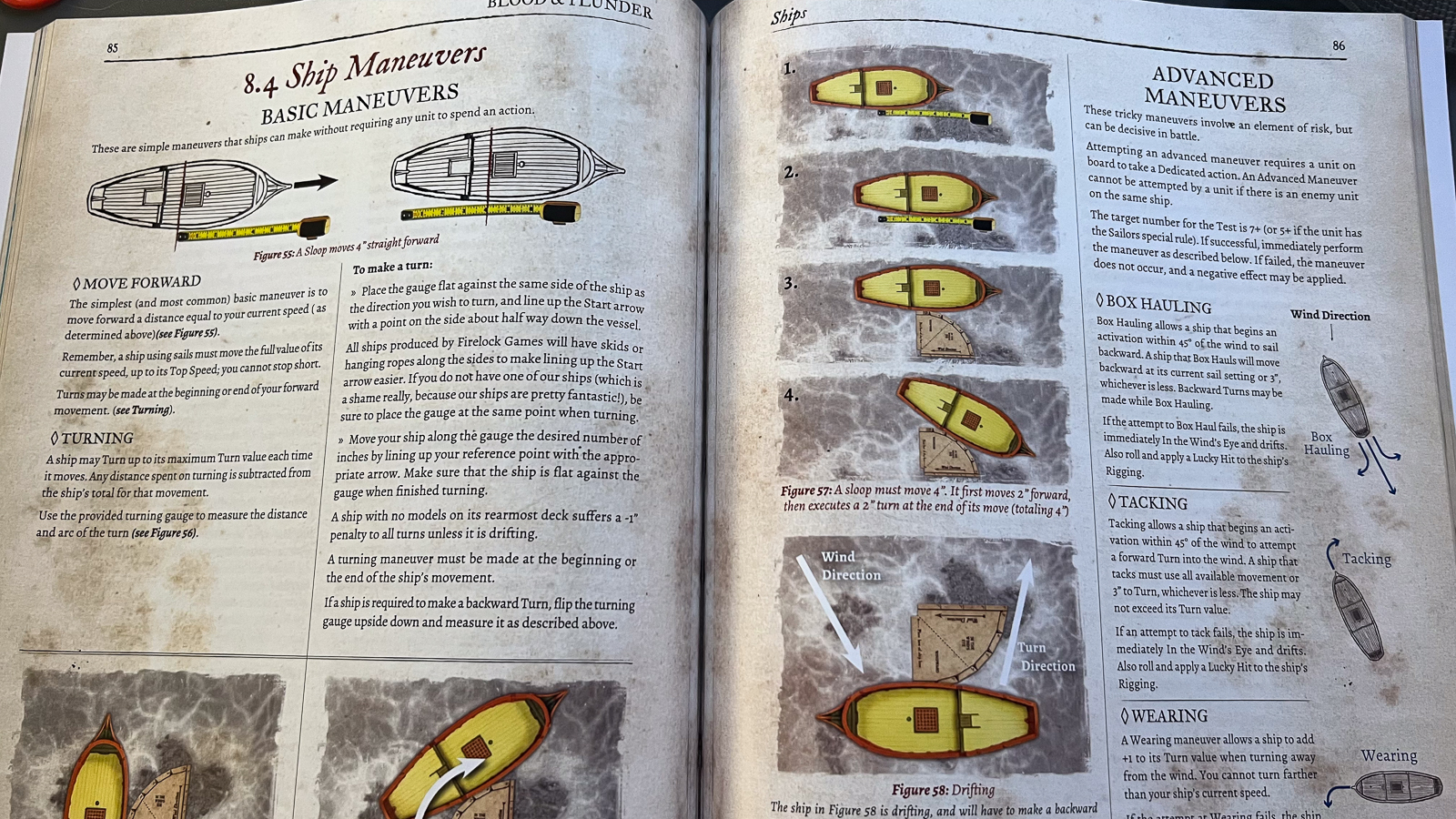
There are rules for nearly every situation and scenario in Blood & Plunder.
And there are a lot of rules. How to hide, how to negotiate water, how to climb, entering buildings, throwables, line of sight, damage to structures, attacks from vantage, how artillery works…and this is all before you get into the even more complicated rules of ship combat, movement, and environmental rules.
For testing purposes and time, I’ll get into ship combat, building, and painting in another article, as it looks complicated and fun. Like real ship combat, there are a lot of actions that make a ship work. You need to devote units to rigging, steering, and combat! Also, there’s tables for weather and wind, not to mention the process of building a sloop, creating rigging & sails, and learning all about naval combat.
When you start playing Blood & Plunder, the book encourages you to play as you read, which can be a little confusing because it doesn’t do the best job in telling the player where certain tables are (Pro Tip: use page 126 for your scenarios, and page 94 to build your force). This box provides enough models to play several 100 point games, which lasted around 2 hours, due to referencing rules on a consistent basis, but we found the gameplay enjoyable. Also, the game comes with punch-board terrain, so you should look around and supply your own, so you can get the full experience of dealing with blocking terrain and elevation.
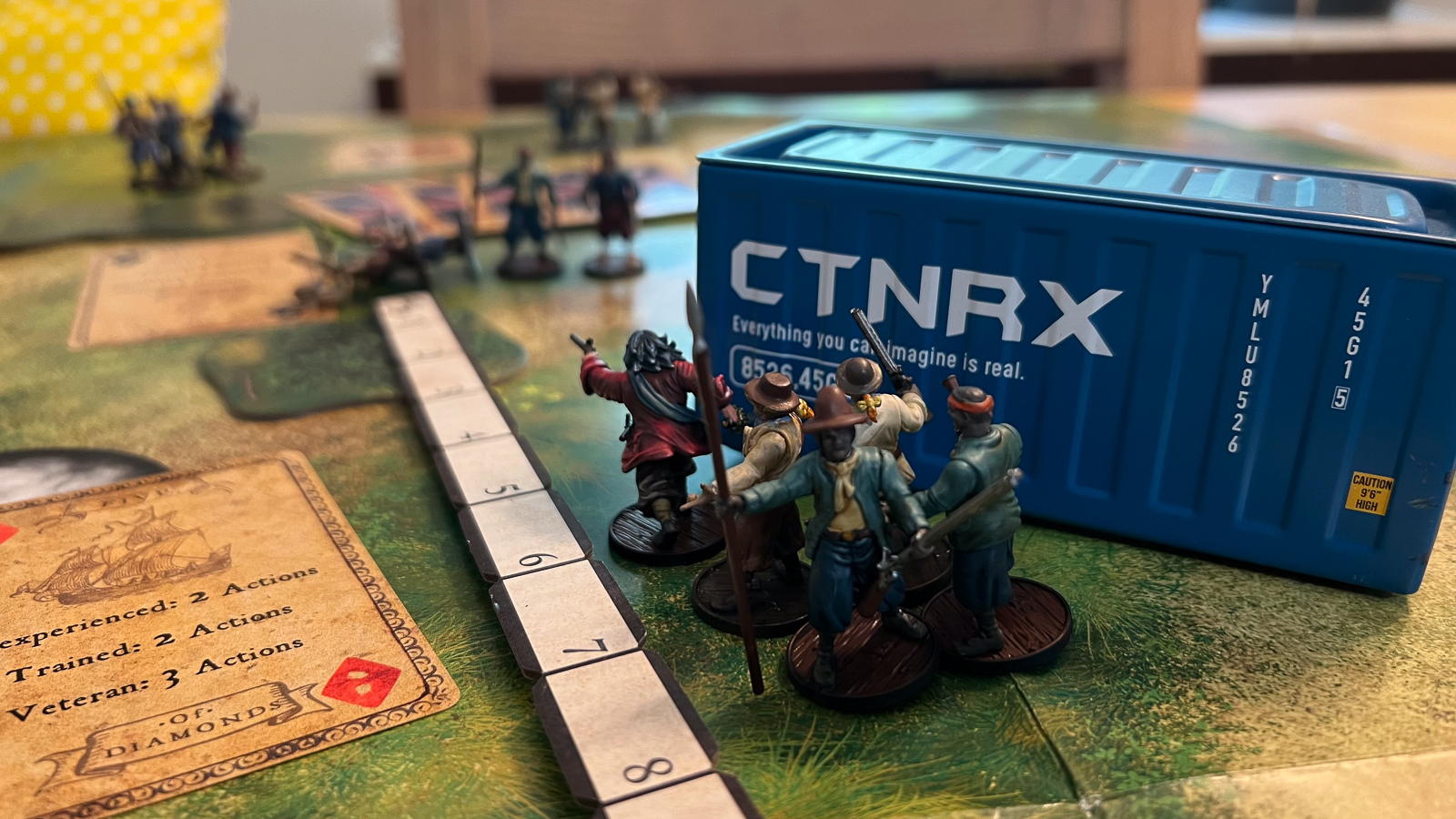
Ultimately though, replayability is going to rely on your willingness to go find players and people who are passionate about Blood & Plunder and other historical wargames, but in my situation, we could only play a few times before interest waned. Hopefully, you have local game stores with a variety of gameplay nights, because I’m sure you’ll find another player(s) there.
Wrap up
This game is great, and this box set is a wildly fantastic deal, allowing players to immediately play two-player games at an affordable price point. The rule system behind it is easy to understand, and how you learn and play is really inventive, and I can see it leading to epic battles on the high seas. That being said, the job of assembling models is annoying and cumbersome, which may turn off some players. At the end of the day, if you decide to purchase this, make the decision based on how much you want to get into this system. Do you have the time? The physical space? Willing players?
Or, if you are just a huge historical nerd, then get this game. You’ll be thrilled.
Blood & Plunder
Good
Blood & Plunder is a fun and approachable wargame at an excellent price point, however, you may have difficulty assembling models and finding people who are willing to jump into the game.
Pros
- Excellent value for a starter set
- Comprehensive rulebook
- Lots of models to customize
Cons
- Painful assembly of models
- You gotta find friends to play
- Box size is a challenge
